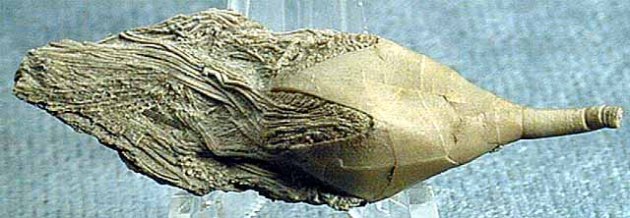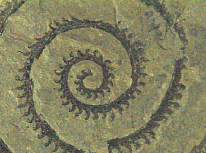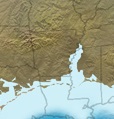Home » Paleontology (Page 9)
Category Archives: Paleontology
Fossil Friday: We may have bats in the belfry, but we’re not crazy.
I know this is getting posted late, sorry about that. I got an unexpected request by a local news reporter to be interviewed about a fabulous new shark fossil found in the Ozark Mountains of Arkansas. I will have to write about that soon. But that’s for later. For today, we have something very different.
This week’s Mystery Monday fossil was a tough one. People are much more used to seeing them alive than as fossils. When people do see them, they usually don’t like them, which is a shame. These little guys are very misunderstood creatures and we owe them a debt of gratitude.
 This picture is from Arthur Harris of the UTEP Biodiversity Collections. It is a jaw from Eptesicus fuscus, the Big Brown Bat. Why a bat, you ask? Because April 17 was National Bat Appreciation Day. Most people do not appreciate bats, holding onto the myth that bats like to fly into people’s hair and give them rabies. In truth, bats do their very best to avoid people. If you weighed less than a pack of cigarettes with fragile bones, would you annoy something that outmassed you by at least 2000 times? The simple fact that bats are the only mammals that can fly is pretty cool, although perhaps less so when one considers that bats make up over 1000 of the approximately 5500 species of mammals. Nevertheless, being able to fly using hands that are each bigger than its body is appreciation-worthy. The fact that their wings are giant hands helps explain why they can fly with such aerobatic skill. We have mechanoreceptor’s in our skin called Meissner’s corpuscles, which allow us to have a well-developed sense of touch in our fingers. Bats have these in huge numbers all over their wings, using them to detect the air pressure on the wings as they fly. The wing is essentially a giant finger tip, sensory speaking. They also have tiny hairs that are very sensitive to airflow over the wings.
This picture is from Arthur Harris of the UTEP Biodiversity Collections. It is a jaw from Eptesicus fuscus, the Big Brown Bat. Why a bat, you ask? Because April 17 was National Bat Appreciation Day. Most people do not appreciate bats, holding onto the myth that bats like to fly into people’s hair and give them rabies. In truth, bats do their very best to avoid people. If you weighed less than a pack of cigarettes with fragile bones, would you annoy something that outmassed you by at least 2000 times? The simple fact that bats are the only mammals that can fly is pretty cool, although perhaps less so when one considers that bats make up over 1000 of the approximately 5500 species of mammals. Nevertheless, being able to fly using hands that are each bigger than its body is appreciation-worthy. The fact that their wings are giant hands helps explain why they can fly with such aerobatic skill. We have mechanoreceptor’s in our skin called Meissner’s corpuscles, which allow us to have a well-developed sense of touch in our fingers. Bats have these in huge numbers all over their wings, using them to detect the air pressure on the wings as they fly. The wing is essentially a giant finger tip, sensory speaking. They also have tiny hairs that are very sensitive to airflow over the wings.
Despite people’s antipathy towards them, bats are very valuable. Without them, we would be eaten alive by mosquitos and all manner of bugs. A little brown bat can eat up to 1000 mosquitos in one hour and a single colony of big brown bats can eat 33 million rootworms in one summer. Big brown bats eat all sorts of insects and are adept at catching them in mid-flight. The spiky, ridged teeth are an adaptation to crunching the hard, chitinous covering of beetles and such types.Bat guano has been used for numerous products, everything from fertilizer, gasohol, antibiotics, and gunpowder. The big brown bat in particular seems to thrive in areas with humans, often setting up colonies on man-made structures. So if you have bats in your belfry, they are probably this type. But don’t worry, they’re helping you.
Even though they are called big brown bats, they are only really big compared to the little brown bat. They attain body lengths up to 13 cm (5″), with a wingspan of a whole foot or more, which is large for a bat. Their fur ranges from tan to a dark chocolate color, with black skin, making their wings black, naturally. Basically, think of your average bat (although a bit smaller than most people’s hyperactive imaginations) and you will be thinking of Eptesicus. They have excellent hearing and can use echolocation to find their way around, although the idea that bats are blind is a complete myth, they see just fine. Because they are small and fly, they need to eat a lot. So to make up for an insatiable appetite, they sleep a lot during winter when food is scarce. A lot. Big brown bats can hibernate over 300 days, almost a whole year. Even so, they can tolerate cooler temperatures than most other bats and can come out of hibernation during winter if need be. They can live for almost 20 years, but most die within their first year. Winter is rough for bats, especially when they are small. They aren’t mature until their second or third year and only have typically only two offspring a year, so they do not have a high reproductive rate. Even if they have a low reproductive rate, their heart rate is staggering. They go from over 400 bpm at rest to well over 1000 bpm in flight. One wonders how they prevent their heart from exploding. It is often said that bats have legs with knees bending the opposite direction of other mammals. This is not really true. What they have are legs which are turned at the hip so far they look backwards.
Fossils of this animal can be found throughout the southern United States all the way down to Venezuala (Kurta and Baker 1990). The genus Eptesicus can also be found throughout Europe. No bat is very common in the fossil record, but these are the most common and widespread. They also seem to be expanding their range. The fossils are found throughout Pleistocene deposits for the past few million years. The current range goes all the way up into Alaska, from the Pacific to Atlantic coasts,and throughout the Bahamas and northern South America. if you want to find fossil bats in Arkansas, I recommend you go into the caves in the Ozark Plateau. Any place you can find modern bats living, there is a decent chance that if you dig down into the floor of the cave, you will find bat fossils.

One down, only 33 million more to go this year. http://www.life.illinois.edu/paige/bats.html
Kurta, A., R. Baker. 26 April 1990. Eptesicus fuscus. Mammalian Species: No. 356, pp.1-10.
Mystery Monday, Tax week edition

For today’s Mystery Monday fossil, we are looking at an animal who is being celebrated this week. No, it’s not a rabbit, Easter is next week. For scale, the bar on top is marked in millimeters, so we are looking at a wee little creature. If getting your taxes done is driving you crazy, spend some nice relaxing time with a fossil.
Fossil Friday
On Monday the fossil shown below was put up. How did you do? We got some very good suggestions about it possibly being a horn or a tooth. It isn’t a horn, not exactly. It does also bear a remarkable resemblance to some spinosaur teeth I’ve seen, which was one of the guesses. But it’s not a tooth either. Congratulations to Laurenwritesscience, who really knows her fossils for correctly identifying it as a horn coral.
 Modern day coral are pretty much all in the group Scleractinia, meaning stony rays, known as the stony corals because they make an external skeleton out of aragonite, a form of calcium carbonate, very similar to calcite. They are the major reef builders in modern oceans. But it wasn’t always that way. Before scleractinians, there were tabulate corals and rugose, or wrinkly corals. Rugose corals, like modern corals formed both large colonies and solitary structures. The solitary rugose corals, like this one, are called horn corals, obviously for their commonly stated similarity to horns.
Modern day coral are pretty much all in the group Scleractinia, meaning stony rays, known as the stony corals because they make an external skeleton out of aragonite, a form of calcium carbonate, very similar to calcite. They are the major reef builders in modern oceans. But it wasn’t always that way. Before scleractinians, there were tabulate corals and rugose, or wrinkly corals. Rugose corals, like modern corals formed both large colonies and solitary structures. The solitary rugose corals, like this one, are called horn corals, obviously for their commonly stated similarity to horns.
Rugose corals first appeared in the Ordovician Period roughly 47o million years ago, give or take 20 million years. They became important reef builders in the Devonian Period and remained a highly visible presence until the end of the Permian about 250 million years ago. They, like almost everything else, succumbed during the Great Dying, as the mass extinction of that time is called. As a result, if you want to find them in Arkansas, you should try the marine limestones in northern Arkansas, throughout the Ozarks. The best place to find them are the Mississippian rocks, such as the St. Joe, Boone, and Pitkin Formations.
Rugose corals, like all corals, are more than just the stony skeleton most people think of when they see coral. Inside, the animals themselves grow as polyps sitting, in the case of horn corals, a stony cup called a calyx, which they constantly build up as they grow. When alive, the pointy end went down, permanently attached to the surface upon which it grew. Inside the calyx, they grow septae, little walls used to provide structural support for the skeleton and to hang themselves on (while this may cause one to picture a very depressed polyp, a better visual image would be hanging pictures or cabinets on a wall). Rugose corals typically grew six main septae, forming six compartments. Four of the compartments were further subdivided by minor septae. All of these septae radiated from a central axis, or rod supporting the whole structure. The four main compartments is one reason why they are sometimes called Tetracorallia.
This is one of the key characteristics that separate them from modern day coral, which are members of a group called Hexacorallia, noted for having six main septae and six main compartments, all of which are furhter subdivided with minor septae, thus having six-fold symmetry (you can draw six lines through the center of the organism in which one side is a mirror image of the other). Hexacorallia also include the sea anemones, also noted for having six lines of symmetry. The Rugosa, on the other hand, due to the four compartments, often exhibited only bilateral symmetry, meaning there was only one plane you could draw to find a mirror image.
The polyp forming the living organism was a tiny creature with a simple sac-like digestive tract, meaning there is only one opening. Food passes into the mouth and waste comes right back out the same way. This is the typical pattern seen in almost all of the Cnidarians, the group in which corals are a part, along with animals like the jellyfish. Like the jellyfish, coral polyps have nematocysts, stinging cells they use to capture prey. Surrounding the mouth, and where one would find the nematocysts, are a ring of tentacles, forming a flower appearance, the reason the group containing all corals is called Anthozoa, the flower animals. A lot of group names and you might be getting lost, so I’ll summarize the names: Horn corals are a part of the Rugosa, or rugose corals, also called Tetracorallia, which are a part of Anthozoa, along with all the other corals and sea anemones, which are a part of Cnidaria, which also includes the jellyfish among others. The modern corals are mostly scleractinians, or stony corals, which are a part of Hexacorallia, which are Anthozoans and thus Cnidarians (which you may also see referred to as coelenterates). Like all members of the Anthozoa, rugose corals almost assuredly reproduced asexually by budding or sexually by releasing both sperm and eggs. In many corals, most of the polyps in an area will do this at or near the same time, called broadcast spawning, creating a massive cloud of eggs and sperm floating around the reef. I have read this is a fascinating sight, if rather disturbing to some. Why do they do this? Because everything else in the reef considers them good eating, so the only way to ensure that some escape long enough to survive and grow is to simply overwhelm them with sheer numbers. This idea is often called predator satiation. It also gets around the fact that coral can’t move, they are the ultimate homebodies. The only hope they have to meet a good mate is to just put the seeds of their offspring into the wind, or in this case, currents, and hope for the best.
Most corals do not depend just on what they can capture or filter out from the water. They also have a mutualistic relationship with photosynthetic dinoflagelates and zooanthellae, or single celled algae. They algae get a safe place to live and nutrients, while the coral gets the products of the photosynthesis, such as oxygen, sugars and amino acids. Normally the coral don’t depend upon the extra energy derived from the photosynthesis, but when times are tough, the added supply can see them through, allowing both the coral and the algae to survive longer. The mutualism certainly provides a much more abundant resource supply for the coral, allowing them to grow more efficiently. We don’t know if rugose coral did this, but it is reasonable to assume they did for now. Of course, this means that corals who use this relationship are restricted to shallow, clear waters conducive to the growth of algae. We do know that they formed close relationships with stromatoporoid sponges. The sponges formed the backbone of the reefs, with the coral growing within the sponge reefs. What sort of association beyond that is not known though.
Mystery Monday

Time for another Mystery Monday fossil! See if you can figure out this wrinkly rock.
Fossil Friday, Having a Blast
It’s Friday, which, along with the anticipations of the weekend, means it’s time for the reveal of this week’s Mystery Monday fossil. We’ve had guesses of starfish, aka sea star, and sea urchins. Both are close. Were you able to guess it?
This fossil is of Pentremites, a echinoderm in the group Blastoidea, so a relative of both sea stars and sea urchins. Like them, you would have found them in shallow marine communities in fairly clear water, if they still lived. Blastoids are what you might get if you crossed a crinoid (another echinoderm) with a sea urchin, but we’ll get to that. This particular image was taken by Dr. Richard Pasilk, of the Humboldt State University Natural History Museum. You can find it and many more fascinating images at the Paleoportal.org fossil galleries.
Echinoderms, or “spiny skin,” have been referred to as walking castles because most of them form plates and spines of calcium carbonate that lock together, forming a mobile fortress. Echinoderms include starfish, sea urchins, crinoids, and holothuroids, or sea cucumbers. Echinoderms are known for having tube feet, a part of their water vascular system. If anyone has seen hydraulic mechanical systems, you know how these work, by pumping water in and out of tubes to change the water pressure, allowing the tubes to extend or contract. They don’t have much in the way of nervous or sensory systems, although sea stars do have rudimentary eyes allowing them to see, albeit very poorly. At least some sea stars can turn their stomachs inside out to eat, and sea cucumbers can basically eviscerate themselves, ejecting their guts through their anus, to gross out potential predators. Sea cucumber poop is also very important for coral reefs, so be a hero, save the sea cucumber, save the ocean.
Blastoids grew on long stalks like crinoids formed of many flat disks, but instead of having fairly disordered plates that formed a rough ball-shaped shell called a theca, the plates forming the blastoid thecae were nicely ordered, arranged in a shell that many have thought resembled a hickory nut. This ordered, integrated theca is much more similar to the echinoid sea urchins than it is the crinoids. It has the advantage for fossil hunters that it held together better, meaning that they are much easier to find than crinoid thecae, which pretty much scattered across the sea floor as unidentifiable calcite crystals as soon as the animal died, unless they were killed by being buried.
The mouth is located at the top, surrounded by five grooves called ambulacra. Coming off the ambulacra were a series of feathery appendages called brachioles, which would filter particles from the water, much like the feathery arms of the crinoids. Between the start of each ambulacra sat an opening. Four of them led to the respiratory system, consisting of complexly folded structures called hydrospires. Loosely fold a piece of paper a couple of times, then roll it up and you will get an idea what it looked like. Water would flow from the brachioles into your paper hydrospire between the edges of the paper and out the top of the tube. The other one was the anus, so the digestive system was U-shaped, with the mouth and anus adjacent to each other.
The fossil record of echinoderms is extensive, starting in the Cambrian over 540 million years and possibly as far back as the Ediacaran around 600 million years ago. The fossil record of the blastoids is somewhat debated. Whereas some sources say they originated in the Ordovician, most put the oldest confirmed blastoid in the Silurian, roughly 425 million years ago. They became abundant in the Mississippian Period and were persistent members of a diverse shallow marine community until they died out by the end of the Permian Period a little over 250 million years ago, along with most of the world in “The Great Dying.” In Arkansas, as in the rest of North America, blastoids were common and diverse in the Mississippian Period, also known as the Lower Carboniferous Period, although they became rare in the Pennsylvanian, the Upper Carboniferous Period. Arkansas has some of the only Pennsylvanian blastoids in North America.

Look for rocks like this. Pitkin Limestone along Hway 65. http://www.geology.ar.gov
If you want to look for them in Arkansas, the best places to go would be the Mississippian age limestones in the Ozark Plateau, such as the Pitkin Limestone and the Boone Formation, and the early Pennsylvanian age limestones, such as the Brentwood Limestone of the Bloyd Formation. Follow Highway 65 north towards Leslie and Marshall and stop at any roadcut through the Ozarks showing whitish rocks and you stand a decent chance of finding them. Just don’t collect in the National Forests and watch the traffic.
Mystery Monday
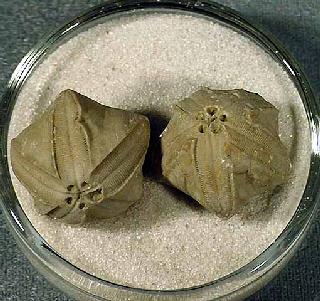
I hope you had a blast over Spring Break. Here is a fossil you might find in Northwest Arkansas. See if you can figure out what it is.
Fossil Friday, Written in Stone
On Monday, I said that the mystery fossil this week takes us back to the beginning and ties us to the present. I also said the answer was written in stone. Could you figure it out? Katharyn D. was the first to get it this week.
The picture shows a graptolite. This particular one is likely a species of Cyrtograptus. Most specimens of this type of graptolite are from Europe, they do appear in Canada and parts of the United States, including Oklahoma, according to Fossilworks.org. Did it appear in Arkansas? We don’t know. Other graptolites did, but then the book of Arkansas graptolites has not yet been written, so the true diversity of graptolites within the state is not really known.
So what are graptolites? The name means “written in stone” because they reminded people of hierogylphs or petrographs, writing or pictures scratched into stone. The first graptolites I remember seeing in the Quachita Mountains reminded me of nothing more than pencil scratches. Others, better preserved, look like saw blades or little tubes. For a long time, no one really knew what to make of them, regarding them as cnidarians, or plants, or even inorganic mineral formations. But with the advent of electron microscopy, most workers have come to the conclusion they are actually members of the group Hemichordata. This conclusion puts them at the very beginnings of all vertebrates. Vertebrates evolved from a group called urochordates, the first animals with a stiffened rod for support, an ancestral spine. Today, urochordates are tiny animals called tunicates, or sea squirts. But even before these animals evolved, there were the hemichordates, meaning “half-chordate.” They share branchial opening, or “gill slits,” a collar-like pharynx, and the beginnings of a notochord, called a stomochord. The main hemichordates alive today are called enteropneusts, or acron worms. If you go any earlier than this, you find yourself in echinoderms.

Graptolites from the Womble shale. http://www.geology.ar.gov

Graptolites from the Womble shale. http://www.geology.ar.gov
Graptolites appeared in the Cambrian Period over 500 million years ago and were thought to have died out in the Mississipian Period (Early Carboniferous), roughly 320 million years ago. They are useful as index fossils, meaning they can be used to date rocks with a fair degree of precision, because they have a worldwide distribution and are common in the rocks, as well as evolving quickly so they have many species, many of which did not last long.
 Graptolites started off growing on the ocean floor, but later ones floated freely in the ocean. When they died, they would sink to the bottom, becoming entombed in the deep ocean sediments. So today, graptolite fossils are usually found in shale formed from the deep ocean mud. Sometimes they can be found in marine limestone or chert, but they are less commonly found there. As a result, the best place to find them is in the shales of the Ouachita Mountains in west-central Arkansas. The best place to find them is in the Womble Shale, a black shale with thin limestone layers and a few small silty sandstone and chert layers. The Womble Formation was named after the town of Womble, which is now Norman, in Montgomery County, AR, so that makes that area a fine place to look. You can also find conodont fossils commonly in those rocks, which are tiny, tony, early chordates. Conodonts were the first animals in the vertebrate lineage with mineralized tissue. They had teeth, but no bone. Other places you can find them are the Arkansas Novaculite in the Ouachitas, although you will have better luck in the older rocks, such as the Mazarn or Collier Shales. You can also find them in any of the Ordovician or Silurian aged Ozark limestones in northern Arkansas, but they will be harder to find as those rocks were formed in shallower water, with many more fossils of many other animals which are far more common, whereas the graptolites will be much rarer than in the Ouachitas. For a full listing and description of the appropriate rocks and maps to their location, try the Arkansas Geological Survery website here.
Graptolites started off growing on the ocean floor, but later ones floated freely in the ocean. When they died, they would sink to the bottom, becoming entombed in the deep ocean sediments. So today, graptolite fossils are usually found in shale formed from the deep ocean mud. Sometimes they can be found in marine limestone or chert, but they are less commonly found there. As a result, the best place to find them is in the shales of the Ouachita Mountains in west-central Arkansas. The best place to find them is in the Womble Shale, a black shale with thin limestone layers and a few small silty sandstone and chert layers. The Womble Formation was named after the town of Womble, which is now Norman, in Montgomery County, AR, so that makes that area a fine place to look. You can also find conodont fossils commonly in those rocks, which are tiny, tony, early chordates. Conodonts were the first animals in the vertebrate lineage with mineralized tissue. They had teeth, but no bone. Other places you can find them are the Arkansas Novaculite in the Ouachitas, although you will have better luck in the older rocks, such as the Mazarn or Collier Shales. You can also find them in any of the Ordovician or Silurian aged Ozark limestones in northern Arkansas, but they will be harder to find as those rocks were formed in shallower water, with many more fossils of many other animals which are far more common, whereas the graptolites will be much rarer than in the Ouachitas. For a full listing and description of the appropriate rocks and maps to their location, try the Arkansas Geological Survery website here.

Cephalodiscus, a type of pterobranch. http://metazoan.auburn.edu/halanych/lab/projects.html
I mentioned that graptolites were thought to have died out in the Mississippian Period. That is because no fossils are found after this date. However, it is thought by most workers that graptolites may still be living today. We just call them pterobranchs, another type of hemichordate and are acorn worm-like animals with plant-like fronds used to filter out plankton from the water.
Fossil Friday, Revenge of the Serpent
Mystery Monday this week fell on St. Patrick’s Day, so to celebrate, the following image was posted for the mystery fossil of the week.
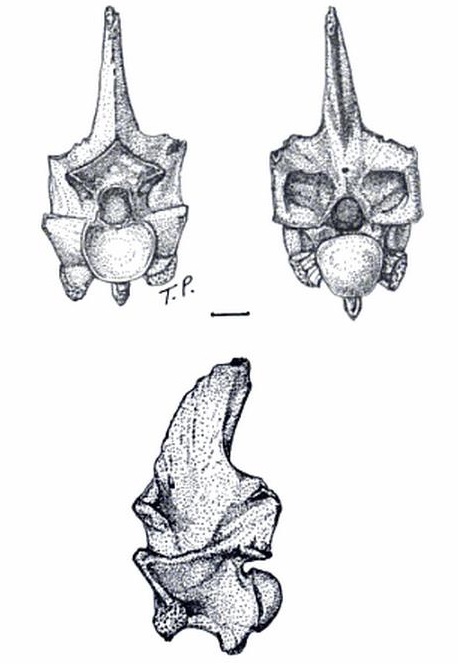 St. Patrick was well known for driving all the snakes from Ireland, at least so the myth goes. In reality, there never were any snakes in Ireland for St. Patrick to drive out in the first place. But unlike Ireland, Arkansas has always had snakes. Right now, we have a diverse population of snakes, including boasting more different types of venomous snakes than most other states, being one of only ten states that have all four types of venomous snakes in the country (there are roughly twenty separate species, but they all fall into four main groups). Here you may find the copperhead, coral snake , cottonmouth (aka water moccasin), and the rattlesnake (including the Timber, Western Diamondback, and pygmy rattlers). At least we can take comfort that we are just outside the ranges of the Massasauga and Eastern Diamondback rattlesnakes and we don’t have the diversity of rattlers seen in places like Arizona and Texas (which may win the prize for most venomous snakes in the country if both species number and diversity are taken into account).
St. Patrick was well known for driving all the snakes from Ireland, at least so the myth goes. In reality, there never were any snakes in Ireland for St. Patrick to drive out in the first place. But unlike Ireland, Arkansas has always had snakes. Right now, we have a diverse population of snakes, including boasting more different types of venomous snakes than most other states, being one of only ten states that have all four types of venomous snakes in the country (there are roughly twenty separate species, but they all fall into four main groups). Here you may find the copperhead, coral snake , cottonmouth (aka water moccasin), and the rattlesnake (including the Timber, Western Diamondback, and pygmy rattlers). At least we can take comfort that we are just outside the ranges of the Massasauga and Eastern Diamondback rattlesnakes and we don’t have the diversity of rattlers seen in places like Arizona and Texas (which may win the prize for most venomous snakes in the country if both species number and diversity are taken into account).
In the past though, we also had other snakes, including Pterosphenus schucherti, also known as the Choctaw Giant Aquatic Snake, a giant sea snake that lived here in the late Eocene roughly 35 million years ago. The Eocene was a much warmer time. In fact, this period falls at the end of what is called the Palaeocene-Eocene Thermal Maximum. There were no polar ice caps during this time, with at least double the amount of carbon dioxide and triple the amount of methane than what we see now. Because of this, Louisiana was pretty much under water and Arkansas had wonderful ocean front property, along with a lot of swamps and marshes. It is likely the cooling during this period into the Oligocene Period, that caused the extinction event that wiped out these snakes, along with several terrestrial mammals, including a variety of Perissodactyl horse ancestors, artiodactyls (cloven hoffed mammals), rodents, and primates.

Pterosphenus model at the Florida Museum of Natural History. It is too wide, though, as noted by the staff of the VMNH paleontology lab, who took this picture.
This was the perfect environment for a number of different snakes, although we don’t have fossil evidence of many. One that we do have is of Pterosphenus. This snake had tall, narrow vertebrae, indicating adaptation to an aquatic lifestyle. In fact, it probably was not able to support itself on land very well due to its thin body.
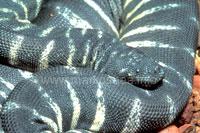
Little file snake, Acrochordus granulatus. http://www.markshea.info
Sea snakes today rate as some of the most highly venomous snakes in the world. However, there are nonvenomous ones as well, such as the marine file snake, Acrochordus granulatus, which live in coastal regions between Asia and Australia. Those of today are relatively small snakes, ranging from half a meter to just over 2 meters (2 feet to 7 feet or so). Pterosphenus, on the other hand, reached lengths of 2.3 m to 5.1 m, or possibly larger.
Unfortunately, we don’t know a whole lot about these snakes, other than they were clearly aquatic. The bones that have been found with them, such as whale bones, have indicated marine waters. Fossils of these snakes have been found in eastern Arkansas, in Saint Francis County in the Eocene deposits around Crow Creek called the Jackson Group.












